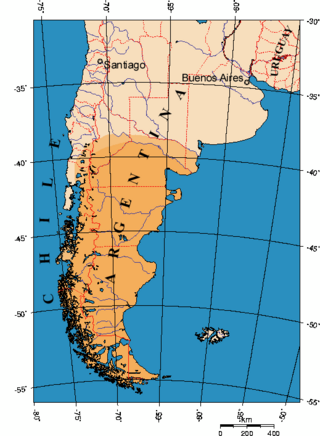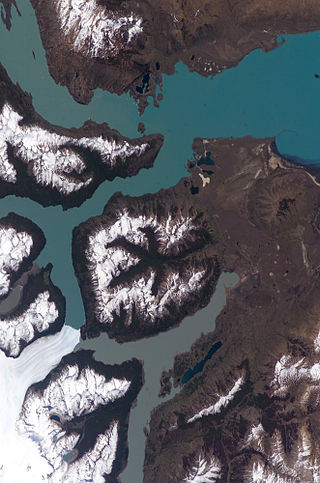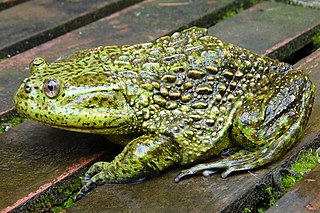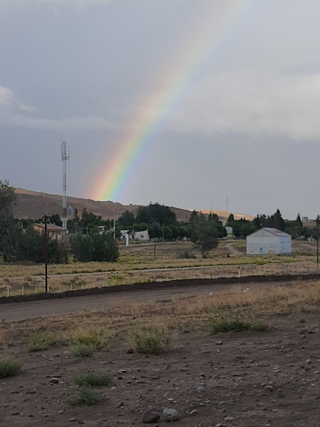
Patagonia is a geographical region that encompasses the southern end of South America, governed by Argentina and Chile. The region comprises the southern section of the Andes Mountains with lakes, fjords, temperate rainforests, and glaciers in the west and deserts, tablelands, and steppes to the east. Patagonia is bounded by the Pacific Ocean on the west, the Atlantic Ocean to the east, and many bodies of water that connect them, such as the Strait of Magellan, the Beagle Channel, and the Drake Passage to the south.

Gondwanatheria is an extinct group of mammaliaforms that lived in parts of Gondwana, including Madagascar, India, South America, Africa, and Antarctica during the Upper Cretaceous through the Paleogene. Until recently, they were known only from fragmentary remains. They are generally considered to be closely related to the multituberculates and likely the euharamiyidians, well known from the Northern Hemisphere, with which they form the clade Allotheria.
Gondwanatherium is a genus of stem-mammal from the extinct suborder Gondwanatheria that lived in Patagonia, South America during the "Age of Dinosaurs", specifically during the Late Cretaceous.

The South Polar region of the Cretaceous comprised the continent of East Gondwana–modern day Australia, Zealandia, and Antarctica–a product of the break-up of Gondwana in the Cretaceous Period. The southern region, during this time, was much warmer than it is today, ranging from perhaps 4–8 °C (39–46 °F) in the latest Cretaceous Maastrichtian in what is now southeastern Australia. This prevented permanent ice sheets from developing and fostered polar forests, which were largely dominated by conifers, cycads, and ferns, and relied on a temperate climate and heavy rainfall. Major fossil-bearing geological formations that record this area are: the Santa Marta and Sobral Formations of Seymour Island off the Antarctic Peninsula; the Snow Hill Island, Lopez de Bertodano, and the Hidden Lake Formations on James Ross Island also off the Antarctic Peninsula; and the Eumeralla and Wonthaggi Formations in Australia.

Aristonectes is an extinct genus of large elasmosaurid plesiosaurs that lived during the Maastrichtian stage of the Late Cretaceous. Two species are known, A. parvidens and A. quiriquinensis, whose fossil remains were discovered in what are now Patagonia and Antarctica. Throughout the 20th century, Aristonectes was a difficult animal for scientists to analyze due to poor fossil preparation, its relationships to other genera were uncertain. After subsequent revisions and discoveries carried out from the beginning of the 21st century, Aristonectes is now recognised as the type genus of the subfamily Aristonectinae, a lineage of elasmosaurids characterized by an enlarged skull and a reduced length of the neck.
The Magallanes Basin or Austral Basin is a major sedimentary basin in southern Patagonia. The basin covers a surface of about 170,000 to 200,000 square kilometres and has a NNW-SSE oriented shape. The basin is bounded to the west by the Andes mountains and is separated from the Malvinas Basin to the east by the Río Chico-Dungeness High. The basin evolved from being an extensional back-arc basin in the Mesozoic to being a compressional foreland basin in the Cenozoic. Rocks within the basin are Jurassic in age and include the Cerro Toro Formation. Three ages of the SALMA classification are defined in the basin; the Early Miocene Santacrucian from the Santa Cruz Formation and Friasian from the Río Frías Formation and the Pleistocene Ensenadan from the La Ensenada Formation.

Dryolestida is an extinct order of mammals, known from the Jurassic and Cretaceous. They are considered basal members of the clade Cladotheria, close to the ancestry of therian mammals. It is also believed that they developed a fully mammalian jaw and also had the three middle ear bones. Most members of the group, as with most Mesozoic mammals, are only known from fragmentary tooth and jaw remains.

The Allen Formation is a geological formation in Argentina whose strata date back to the Late Cretaceous (middle Campanian to early Maastrichtian. Dinosaur remains are among the fossils that have been recovered from the formation. Indeterminate chelid remains and other vertebrates have also been discovered in this formation.
The Divisaderan age is a South American land mammal age, covering a period of geologic time within the Middle and Late Eocene epochs of the Paleogene. It follows the Mustersan age and is followed by the Tinguirirican age.

The Chorrillo Formation, also named as Chorillo Formation, is a Maastrichtian geologic formation in southern Patagonia, Argentina. The formation is more than 50 metres (160 ft) thick and underlies the Calafate Formation and rests on top of the La Irene Formation.
Sudamericidae is a family of gondwanathere mammals that lived during the late Cretaceous to Miocene. Its members include Lavanify and Vintana from the Cretaceous of Madagascar, Bharattherium (=Dakshina) from the Cretaceous of India, Gondwanatherium from the Cretaceous of Argentina, Sudamerica from the Paleocene of Argentina, and unnamed forms from the Eocene of Antarctica and Cretaceous of Tanzania. More recently, Patagonia, a mammal from the Colhuehuapian stage of the Miocene of southern South America, has been suggested to be a sudamericid.
Coloniatherium is a meridiolestid mammal from the Late Cretaceous of Argentina. The single species, Coloniatherium cilinskii, was a large member of the family Mesungulatidae.

The Calyptocephalellidae are a family of toads found in Chile containing two living genera, Calyptocephalella and Telmatobufo.

The Mata Amarilla Formation is a fossiliferous formation of the Austral Basin in southern Patagonia, Argentina. The formation consists of sediments deposited during the Middle Cenomanian, dated to 96.94 to 95.52 Ma. The middle section of the formation was previously considered to be the Pari Aike Formation.

Patagonia comprises the southernmost region of South America, portions of which lie on either side of the Argentina-Chile border. It has traditionally been described as the region south of the Rio, Colorado, although the physiographic border has more recently been moved southward to the Huincul fault. The region's geologic border to the north is composed of the Rio de la Plata craton and several accreted terranes comprising the La Pampa province. The underlying basement rocks of the Patagonian region can be subdivided into two large massifs: the North Patagonian Massif and the Deseado Massif. These massifs are surrounded by sedimentary basins formed in the Mesozoic that underwent subsequent deformation during the Andean orogeny. Patagonia is known for its vast earthquakes and the damage they cause.

The Collón Curá Formation is a Middle Miocene fossiliferous geological formation of the southern Neuquén Basin in northwestern Patagonia and the western Cañadón Asfalto Basin of central Patagonia, Argentina. The formation crops out from the southern Neuquén Province, the western Río Negro Province to the northern Chubut Province.
The Cañadón Asfalto Basin is an irregularly shaped sedimentary basin located in north-central Patagonia, Argentina. The basin stretches from and partly covers the North Patagonian Massif in the north, a high forming the boundary of the basin with the Neuquén Basin in the northwest, to the Cotricó High in the south, separating the basin from the Golfo San Jorge Basin. It is located in the southern part of Río Negro Province and northern part of Chubut Province. The eastern boundary of the basin is the North Patagonian Massif separating it from the offshore Valdés Basin and it is bound in the west by the Patagonian Andes, separating it from the small Ñirihuau Basin.

The Dorotea Formation is a geological formation in the Río de Las Chinas Valley of the Magallanes Basin in Patagonian Chile whose strata date back to the Campanian to Maastrichtian of the Late Cretaceous.

The Santa Cruz Formation is a geological formation in the Magallanes/Austral Basin in southern Patagonia in Argentina and in adjacent areas of Chile. It dates to the late Early Miocene epoch, and is contemporaneous with eponymous Santacrucian SALMA. The formation extends from the Andes to the Atlantic coast. In its coastal section it is divided into two members, the lower, fossil rich Estancia La Costa Member, which has a lithology predominantly consisting of tuffaceous deposits and fine grained sedimentary claystone and mudstone, and the upper fossil-poor Estancia La Angelina Member, which consists of sedimentary rock, primarily claystone, mudstone, and sandstone. The environment of deposition is interpreted to have been mostly fluvial, with the lowermost part of the Estancia La Costa Member being transitional between fluvial and marine conditions. The environment of the Estancia La Costa Member is thought to have been relatively warm and humid, but likely became somewhat cooler and drier towards the end of the sequence. The Santa Cruz Formation is known for its abundance of South American native ungulates, as well as an abundance of rodents, xenarthrans, and metatherians.

Gonkoken is an extinct genus of hadrosauroid ornithopod dinosaur from the Late Cretaceous Dorotea Formation of Chilean Patagonia. The genus contains a single species, G. nanoi, known from disarticulated bones of multiple individuals.















